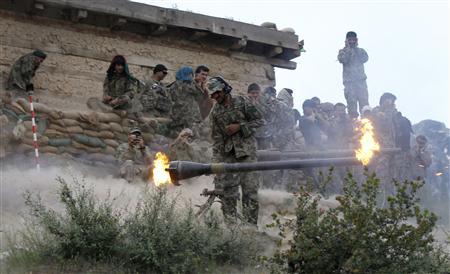(Reuters) – – U.S. troops returned to the area in Afghanistan they call the “dark side of the moon” this week, a remote Hindu Kush region that controls several access routes to Kabul and where the coalition suffered one of its biggest reverses in the decade-long war.

This part of Nuristan province, in the mountainous far east of Afghanistan, could be the target of a planned Taliban offensive, coalition commanders say.
Carrying “speedballs” – black body bags packed with mortars, ammunition and heavy machine guns – a company of U.S. soldiers landed by helicopter on a narrow ridge and trudged up to a tiny Afghan army post overlooking icy peaks and plunging river valleys, as hostile as breathtaking.
With U.S. intelligence pointing to a possible attack by as many as 1,800 Taliban, the soldiers set up weapons over a backyard-sized square, while Afghan army soldiers in camouflage and plastic sandals pointed out fires and torchlight in the distance in the chill night air.
“We’ll get some eyes overhead to check it out. If it’s Taliban, we’ll get a plane up in the morning and drop a bomb on it,” said U.S. Major Jared Bordwell as some of his men from the 1-12 Infantry Regiment dropped down in the dust and tried to get some sleep.
American soldiers withdrew from Nuristan, or the “land of light”, after around 300 insurgents overran an isolated combat outpost near Kamdesh village – below where Bordwell’s men were huddled – on October 3, 2009, killing eight soldiers and wounding 22.
The former U.S. and NATO commander in Afghanistan, General Stanley McChrystal, decided in 2010 to give up remote combat outposts and shift American troops to protect larger population centers.
But it was through here that the Taliban shifted men and weapons for a suicide assault on Kabul’s diplomatic and government quarter in April, circling beyond the reach of U.S. and Afghan army positions to the south in neighboring Kunar province, coalition commanders say.
With Nuristan now a Taliban staging post and haven, the province is a vital pocket for U.S. forces based in Kunar, with only a few hundred Afghan soldiers and police over an area of 5,800 square km.
“Nuristan remains for me a challenge, a black hole. My line in the sand stops at the Kunar and Nuristan borders,” said Lt-Colonel Scott Green, a wiry former Ranger who oversees Nuristan.
But he will not be in the region for long – NATO troops are due to be withdrawn from north Kunar by October. Green and his men, who are based in Kunar and in Nuristan temporarily, will be among those withdrawn.
So his reduced-strength 1st battalion has to counter insurgents while simultaneously building Afghan capability and “retrograding” – closing up U.S. bases – all within months.
It is one of the most hostile areas in war-torn Afghanistan in a landscape that is equally hostile. Taliban and al Qaeda fighters pass through easily, from either Pakistan or from bases located out of easy NATO reach inside a 4 km-wide border buffer zone.
As many as 2,500 Taliban are thought to be in the province, controlling most districts, and around 300 are foreign, mostly Pakistanis or Chechens, Afghan commanders say.
The insurgents control what few roads there are and have three ways to move deeper into Afghanistan, through either the Kunar, Waygal or Parun valleys, which then wind down into provinces nearer to Kabul.
UP AT DAWN
The next day, Bordwell’s soldiers were up in their body armor and crouched over guns at 4 a.m. to repel a dawn attack that did not happen. Then, they started to coach Afghan soldiers in everything from weapons care to their own health.
The sand-bagged positions became insufferably hot as the sun rose, while the translucent mountain stone underfoot flaked and crumbled to a glittering dust that glued itself to weapons and bodies, as unstable as the province’s security.
“Tell them to drink water. They will get dehydrated in body armor,” said one U.S. officer to a nodding Afghan interpreter.
Bordwell’s soldiers have come back to Kamdesh under a shift this year in NATO’s strategic focus from the Taliban’s southern heartlands to target supply routes and havens in the east, and also to back a former enemy turned warlord ally.
The fighting season began early this year in what has been called Afghanistan’s “lost” province after the Taliban turned against former Hezb-e Islami insurgent and local strongman, Mawlawi Sadeq, who has aligned his militia with the government.
Sadeq, still listed on U.S. government ‘capture or kill’ lists, turned up with seven other local elders to attend a ‘shura’ meeting with Bordwell and the accompanying U.S. mentor to Afghan forces, Lt-Colonel Rocky Burrell.
“We are happy with you guys coming here and listening to our problems. Our government is not doing anything,” said the aging warlord.
“If you are able to support us with heavy weapons it will be very good. I don’t think there would be any bad guys anymore.”
AIRSTRIKES AND GEMS
Burrell, a veteran of years of U.S. special forces operations in Guatemala, Panama, El Salvador and Colombia, says securing Nuristan would probably take thousands of Afghan soldiers that the government does not have, even though it is one of the country’s most mineral-rich provinces.
An Afghan militia member, Mohammad Ghazi, arrived at the post to have a bullet wound on the back of his head treated by U.S. medics and warned local people were deeply worried about the American pullout from Kunar and the entire country in 2014.
“There are a lot of Taliban around. If the (U.S.) supports the Afghan government it will be very good in future. If not, it will be worse,” Ghazi said.
As the hours passed, Bordwell called air strikes on Taliban fighting positions, with Apache helicopter gunships firing incendiary white phosphorous rockets into caves on a mountainside thought to hide an insurgent gun position.
As forest fires continued to burn from the strikes, a U.S. warplane dropped two bombs on a ridge across the valley, while soldiers hurled mortar shells onto river rapids where Afghan troops believe the Taliban like to gather.
TALIBAN CONTROL
Green acknowledged the Taliban controlled most of the districts within his nominal Nuristan command, which he sees from his north Kunar battalion command at Forward Operating Base Bostick as a line of snow-covered peaks on the horizon.
“I would not disagree with that. The hard part is that while you can say they are Taliban-controlled, that’s only because there is such a limited (U.S. security) presence up there,” he said.
Outside, the thump of outgoing 120mm mortar fire shook his headquarters, a low collection of white-washed huts beside a river flanked by vaulting, folded hills known as “rocket ridge”.
The terrain was proving as difficult for the Taliban as for the NATO-led coalition, Green said. The infamous Nuristan rebel commander Dos Mohammad – who led the attack on Combat Outpost Keating in the 2009 Battle of Kamdesh – had now reportedly moved south into Kunar, he said.
“There’s good and bad there for us. The good is he’s out of Nuristan. The bad is he’s a guy who made a name at COP Keating for rallying insurgents and overrunning U.S. bases,” Green said.
There were signs, though, in northern Kunar – another long-time insurgent supply route and stronghold – that were cause for hope ahead of the American pullback, Green said.
Insurgents have been mostly pushed away from the flashpoint Saw Valley in the south, a traditional Taliban supply inroad, and divisions between different militant groups in other areas that led to an insurgent crossfire.
Green was confident security by Afghan forces would be possible in parts of his command within the two years before NATO’s combat exit, but said securing all of Nuristan would remain difficult.
“I think we can transition in Kunar,” he said. “But if we were to try and expand without increased combat power there, then yes, I do think that we would be spread so thin that it would start to break.”
(Editing by Sanjeev Miglani and Raju Gopalakrishnan)





